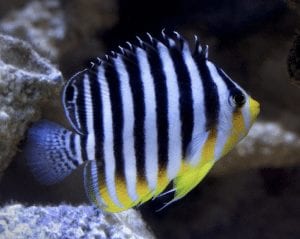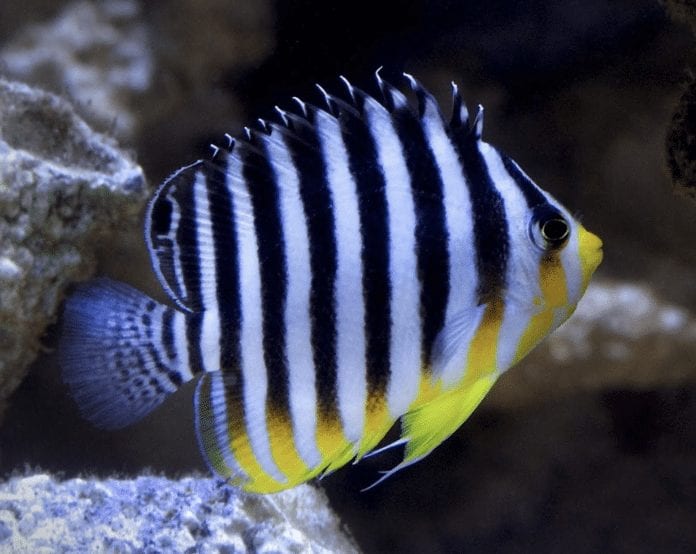Care Requirements for the Multibarred Angelfish (Paracentropyge multifasciata)
- Care Level: Difficult
- Temperament: Semi-aggressive
- Diet: Omnivore
- Water Conditions: 72-78° F, dKH 8-12, pH 8.1-8.4, sg 1.020-1.025
- Maximum size: 4.5 inches
- Origins: Indonesia, Marshall Islands, Vanuatu
- Family: Pomacanthidae
- Tank Size(minimum): 70 gallons
- Reef Safe: With Caution

Physical Traits of Multibarred Angelfish
With bold black stripes side by side with equally bold white stripes the Angelfish’s distinct look separates it from the rest of the pack in the coral community. There are splashes of yellow that find their way onto the scales in a variety of patterns, usually brightly coloring the underbelly up toward the mouth or reaching the tail fin. The dorsal fins are complete with sharp spines, or filaments, that extend out from each individual fin.
Male and female patterns are indistinguishable from one another, so caution when experimenting with two in a large tank. Juveniles can be distinguished by the deep blue or black “eyespot” on their dorsal fin. A common trait of many fish, this gives the illusion that their tail is the head of the body.
Tank Conditions for Multibarred Angelfish
Considered to be a pygmy Angelfish, it only gets to about 4.5 inches max when fully grown. However, many only grow to about 2 inches. They will still run you about $80 to obtain one of these guys.
Separate from its cousin and other members of the Pomacanthidae family, Multibarred’s are “deep water” fish. They often live at depths around 200 feet, near reef fallout areas and deeper valleys. They can be found at higher depths and even lagoons when in search of food. Because of their preferred depth, optimal tank conditions would be a few degrees cooler than most other tropical fish. This can make acclimation difficult and is one of the main reason the Multibarred is not uncommon in captivity.
Acclimation is key here and will include a quarantine period of up to two weeks. This will give the fish the best chance of adapting to new water temperatures, allowing it to recover from a long transport.
Feeding Habits of Multibarred Angelfish
The multibarred angelfish’s diet is mostly that of an herbivore, although they will eat meaty proteins at times. They should be fed 2-3 times a day with plenty of live rock in the tank to allows for supplemental grazing. A tank should be at least 6 months old to provide enough naturally grown algae to support an Angelfish’s constant grazing. Use caution and monitor your angelfish for nipping at sessile invertebrates including coral and tridacnid clams.
Learn more about caring for Angelfish


















